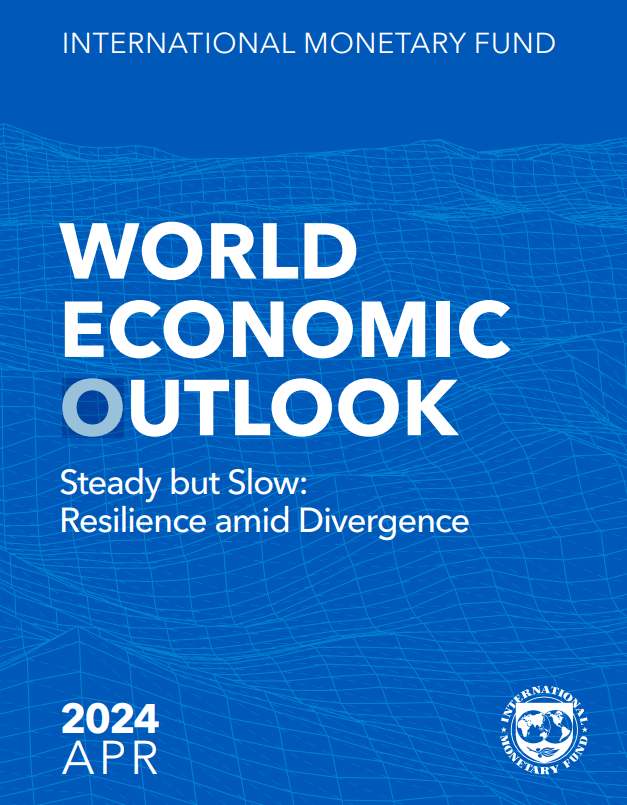
□ 국제통화기금은 한국의 올해 실질 국내총생산(GDP) 증가율 전망치로 2.3%를 제시했는데, 이는 정부(2.2%)와 한국은행(2.1%), 한국개발연구원(KDI·2.2%), 경제협력개발기구(OECD·2.2%)보다 소폭 높은 전망치임. 내년 성장률 전망치 역시 기존의 2.3%를 유지함
□ 국제통화기금은 매년 4월과 10월 전체 회원국을 대상으로 세계경제전망을, 1월과 7월에는 주요 30개국을 상대로 수정전망을 발표함. 올해 세계성장률 전망치는 3.1%에서 3.2%로 0.1%포인트 높여 잡음. 특히 미국 경제가 예상보다 강하게 성장할 것으로 전망하며, 미국 경제성장률 전망치를 2.1%에서 2.7%로 0.6%포인트 상향 조정함
□ 글로벌 성장세엔 상·하방 요인이 균형을 이루고 있다는 게 국제통화기금의 진단임. 상방 요인으로는 전 세계 '선거의 해'(Great Election Year)를 맞아 각국 재정부양 확대, 조기 금리인하 등이 성장률을 높일 수 있다고 봄. 반면 지정학적 갈등 확산, 고금리 속 부채 부담, 중국의 경기둔화 등이 성장률을 제약할 것이라고 지적함
□ 국제통화기금은 통화정책과 관련해선 '국가별 물가 상황에 따라 적절한 시점에 통화정책을 완화할 필요가 있다'며 조급한 통화완화를 경계함. 그러면서 '미래 위험에 대비하기 위해 재정 여력을 확충하고, 중장기 생산성 향상과 함께 기후변화 대응력을 제고해야 한다'고 권고함
[출처]
IMF '한국, 올해와 내년 2.3% 성장'…석달전 전망치 유지 (2024.04.16.) / 연합뉴스
목차
Assumptions and Conventions viii
Further Information x
Data xi
Preface xii
Foreword xiii
Executive Summary xvi
Chapter 1. Global Prospects and Policies 1
Disinflation amid Economic Resilience 1
The Outlook: Steady Growth and Disinflation 7
Risks to the Outlook: Broadly Balanced 16
Globally Consistent Risk Assessment of the World Economic Outlook Forecast 19
Policies: From Fighting Inflation to Restocking Fiscal Arsenals 20
Box 1.1. Fragmentation Is Already Affecting International Trade 24
Box 1.2. Risk Assessment Surrounding the World Economic Outlook’s
Baseline Projections 25
Commodity Special Feature: Market Developments and the Power of Prices 29
References 41
Chapter 2. Feeling the Pinch? Tracing the Effects of Monetary Policy through Housing Markets 43
Introduction 43
Monetary Tightening and Real Estate: Context and Stylized Facts 45
The Housing Channels of Monetary Policy Transmission 47
Housing Channels Vary Significantly across Countries 49
Housing Channels May Have Weakened in Many Countries 55
Policy Implications 57
Box 2.1. Interest Rate Pass-Through in Europe 58
Box 2.2. China’s Monetary Policy and the Housing Market 60
References 61
Chapter 3. Slowdown in Global Medium-Term Growth: What Will It Take to Turn the Tide? 65
Introduction 65
Insights from Medium-Term Forecasts 67
How Did We Get Here? 68
Where Is Growth Heading? 75
Conclusions and Policy Recommendations 77
Box 3.1. Allocative Efficiency: Concept, Examples, and Measurement 79
Box 3.2. Distributional Implications of Medium-Term Growth Prospects 80
Box 3.3. The Potential Impact of Artificial Intelligence on Global Productivity and
Labor Markets 82
References 84
Chapter 4. Trading Places: Real Spillovers from G20 Emerging Markets 87
Introduction 87
G20 Emerging Markets in the Global Economy 90
Aggregate Spillovers in the Short Term 93
Spillovers from Trade and Global Value Chains 95
Can the Other G20 Emerging Markets Support Global Growth? 101
Conclusions and Policy Implications 102
Box 4.1. Industrial Policies in Emerging Markets: Old and New 104
Box 4.2. Capital Flows to G20 Emerging Markets and the Allocation Puzzle 105
Box 4.3. Spillovers from G20 Emerging Markets to Sub-Saharan Africa 106
References 107
Statistical Appendix 111
Assumptions 111
What’s New 111
Data and Conventions 112
Country Notes 113
Classification of Economies 115
General Features and Composition of Groups in the World Economic Outlook
Classification 115
Table A. Classification by World Economic Outlook Groups and Their Shares in
Aggregate GDP, Exports of Goods and Services, and Population, 2023 117
Table B. Advanced Economies by Subgroup 118
Table C. European Union 118
Table D. Emerging Market and Developing Economies by Region and Main Source
of Export Earnings 119
Table E. Emerging Market and Developing Economies by Region, Net External Position,
Heavily Indebted Poor Countries, and Per Capita Income Classification 120
Table F. Economies with Exceptional Reporting Periods 122
Table G. Key Data Documentation 123
Box A1. Economic Policy Assumptions underlying the Projections for Selected Economies 133
List of Tables 137
Output (Tables A1–A4) 138
Inflation (Tables A5–A7) 145
Financial Policies (Table A8) 150
Foreign Trade (Table A9) 151
Current Account Transactions (Tables A10–A12) 153
Balance of Payments and External Financing (Table A13) 160
Flow of Funds (Table A14) 164
Medium-Term Baseline Scenario (Table A15) 167
World Economic Outlook Selected Topics 169
IMF Executive Board Discussion of the Outlook, April 2024 179



